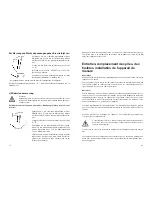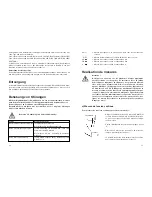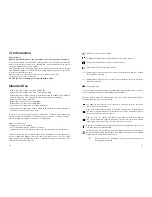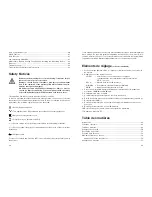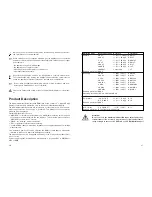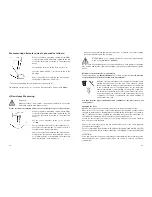
34
For measuring alternate currents, proceed as follows:
- Connect the black measuring cable with the COM
socket (7) and the red measuring cable with the V
Ω
socket (6) until these are plane in the measuring
device.
- Set the range selection switch (5) to position "V".
- Press the button "SELECT" in order to switch to the
AC range.
- Now connect the two measuring tips with the mea-
suring object (generator, circuit, etc.).
- The current measuring value is displayed on the display (1).
The alternate current range "V ~" shows an input resistance of approx. 10 MOhm.
c) Resistance Measuring
Attention!
Make sure that all circuit parts, circuits and modules as well as other
measuring objects are without voltage.
For the resistance measuring and acoustic continuity test, proceed as follows:
- Connect the black measuring cable with the COM
socket (7) and the red measuring cable with the V
Ω
socket (6) until these are plane in the measuring
device.
- Set the range selection switch (5) to position
"
Ω
".
- Check the measuring cables for throughput by con-
necting both measuring tips. This must result in a
resistance value of approx. 0 Ohm.
- Now connect the two measuring tips with the mea-
suring object. Inasmuch as the measuring object is
not high-impedance or interrupted, the measuring
value is displayed on the display (1).
43
- Close the casing carefully again. Make sure you do not deform the contact springs
in the measuring device when inserting.
ATTENTION! Do not operate the device under any circumstances
when its open! MORTAL DANGER!
Do not leave any spent batteries in the measuring device. Even leak-proof batteries
may corrode and release chemicals that impair your health respectively damage the
device.
Disposal of spent batteries / accumulators
You are required by law (Battery Ordinance) to return all spent batteries. Disposing
of spent batteries in the household waste is prohibited!
Batteries / accumulators that contain hazardous substances are
marked with the symbols on the side. These symbols indicate
that it is prohibited to dispose of these batteries / accumulators
in the household waste. The abbreviations for the respective
heavy metal are: Cd = cadmium, Hg = mercury, Pb = lead. You
can return spent batteries respectively accumulators that can no
longer be charged free of charge to the collection points in your
community, our outlets or everywhere else where batteries or
accumulators are sold.
You thus fulfil the legal requirements and contribute to the protection of our
environment!
Changing the Fuse
Observe the safety notices under all circumstances when changing the fuse!
Make sure you only use fuses of the stated type and the indicated nominal current
strength as replacements. Repairing fuses or bridging the fuse holder is not permit-
ted! To exchange the fuses, separate the measuring device from the measuring cir-
cuit, remove all measuring cables and turn the measuring device off.
Loosen the three screws on the back of the casing and open the casing carefully.
Now you can access the fuses.
Remove the defect fuse(s) and replace it/them with others of the same type and
nominal current strength.
Fuse 1 for protecting the mA range: 0.5A 250 V swift tripping, 5x20 mm (F0.5A 250V)
Fuse 2 for protecting the 10 A range: 10A 250 V swift tripping, 5x20 mm (F10A 250V)
ATTENTION!
Close and screw the casing shut carefully again after replacing the fuse. Only put the
measuring device into operation again when the casing is securely closed and
screwed shut.




